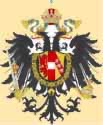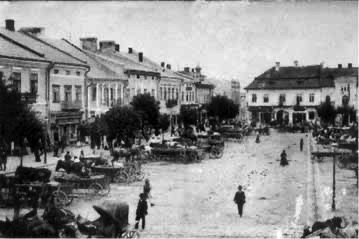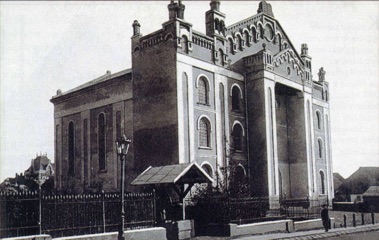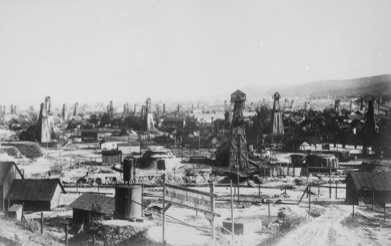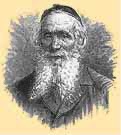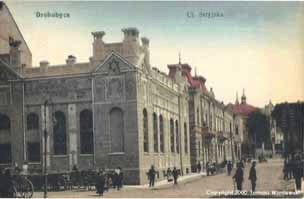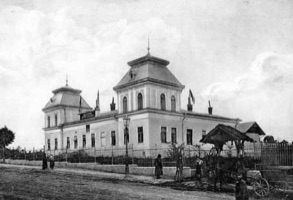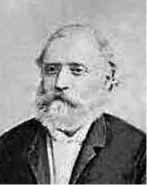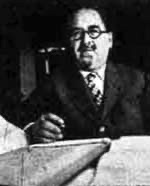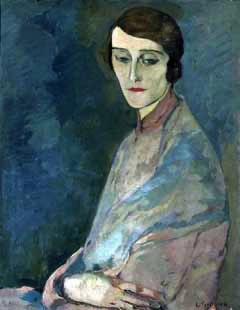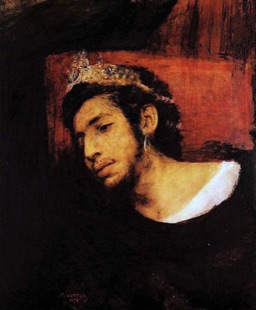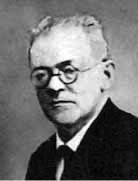Enter Text
Coat of Arms of Drohobycz
Early History and the Commonwealth of Poland
History of the Jewish Community in Drohobycz
Drohobycz Develops as a Centre for Trade
The Marketplace in Drohobycz
From the collection of Claudia Erdheim
Austrian Rule
Coat of Arms of the Austrian Empire
The Choral Synagogue in Drohobycz
Abraham Schreiner
ca 1812-1898
Boryslaw Oil Fields
Progressive Synagogue on Stryj Street in Drohobycz
Jewish Hospital in Drohobycz
Asher Zelig Lauterbach
Shmuel Avraham Apfel
Leopold Gottlieb, Portrait of a Woman
Maurycy Gottlieb, Self-Portrait as Ahasuerus
Ephraim Moses Lillien: Self-Portrait

Dr. Leon Sternbach, born in 1864, was the son of one of the leaders of the Jewish community in
Drohobycz. He studied classical linguistics at Vienna and later Leipzig and was appointed lecturer at the
University of Lemberg in 1889 at the age of twenty-five In 1892, he became Professor at the University of
Cracow.
Photograph from the collection of Marie Zielinska
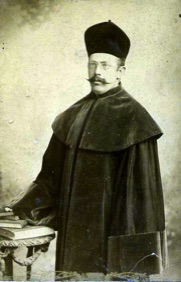
Dr. Leon Reich (1879-1929) was born in Lemberg, Reich joined the Zionist movement in his youth and founded
thefirst Zionist students’ union in Galicia. After studying in Paris he became known as a lecturer and writer. As
head of the Galician Zionist movement he was also involved in the political struggle for the civil rights of Jews
and was a candidate for the Austrian Parliament in the elections of 1911.
By permission of Irgun Yotzei Borysław-Drohobycz and Surroundings in Israel
World War I
Coat of Arms of Poland, 1919-1927
The Second Republic of Poland
The First Jews in Drohobycz
Published by permission of Irgun Yotzei Borysław-Drohobycz
and Surroundings in Israel
1859
By this year, the Jewish population of Borysław numbers about 1,000. Poor people here find oil on their land
and become rich overnight. Of twelve oil refineries, Jews own ten. Only Jewish workers are employed in oil
production during this period. They establish a sick fund for fellow employees.
1860's
The maskilim open a private, Jewish, secular gymasium (high school) with twenty children who study Hebrew,
German, Polish, mathematics and Talmud. The khassidim, aided by melameds (traditional Hebrew teachers)
oppose the school. However, as enrolment grows, they accept the gymnasium in return for the right to appoint
a teacher of religion there. Increasing contact with Jews from other cities and with non-Jews accelerates cultural
assimilation and general education among the merchant families of Drohobycz. Moderate maskilim take political
command of the community.
During this period, many die in a cholera epidemic.
1861
An era of constitutionalism begins. Galician Jews begin a political struggle for legal equality.
1862
The wax industry begins to develop rapidly. More than 1500 wax wells are in operation in Borysław and
Wolanka. The industry attracts hundreds of labourers, called lebaks to Borysław. Some settle in the town and
commute from their villages.
1863
The Groyse Shil or Great Synagogue is finished and dedicated on shavuoth of 1863. Drohobycz now has two
synagogues, twenty-four private batei midrash (houses of study). An Osei Hesed (bikur holim), a hospital is soon
founded to care for the sick.
1700s
Early in the century conditions improve for Jews who now dominate all commerce, industry and trades, including the export trade in Drohobycz. Unlike Jewish lessees in other cities, those of Drohobycz employ fellow Jews as clerks and minor functionaries, thus establishing a practice that will continue in Jewish-owned businesses in the town. Without realizing it, they lay the foundation for creating a Jewish middle class and influence Jewish life in the town for the next two centuries.
Jewish merchants also attend fairs throughout Germany, export oxen to Silesia and developing the cloth trade and banking. Jewish traders take the Drohobycz route to visit the famous Jewish moneychangers there to .
exchange their Polish money for foreign currency before
1000-1100
Jews first visit the Carpathian area as traders. Ashkenazim migrate to Great Poland from Germany in the West.
Jews of Byzantine cultural patterns and perhaps some traces of Khazar ethnic descent and culture migrate to the
region of Lwów from Kiev in the East.
1249
Batu Khan, the grandson of Ghenghis Khan, leads a Tatar invasion of Galicia and southern Poland in this year.
Polish kings, anxious to rebuild devastated urban areas, welcome Jews who come from Germany.
1264
King Bołeslaw V, the Pious proclaims the Statute of Kalisz, which serves as the basis for the legal position of the
Jews in Poland until 1795.
Larger numbers of Jews from Germany are invited by the Polish King. In eastern Galicia the western Ashkenazic
culture becomes dominant.
1287
1340
Red Ruthenia, or eastern Galicia, becomes part of Poland under King Casimir the Great (1340-1370). Casimir
improves the Statute of Kalisz to protect Jewish civil rights as well as commercial privileges.
1340
The first record of a church built in Drohobycz.
1404
Earliest record of Jewish inhabitants in Drohobycz is dated 1404. Only Jews who are lessees of salt mines
are permitted to live within the town; other Jews live in the suburb, Na Lanie. Jews receive permission to settle
in lands adjoining the mines but are denied permission to have a cemetery to discourage them from establishing
a permanent community.
King Władisław II Jagiełło entrusts to the Jew Wolczko the salt mines of Drohobycz because of "his industry and
wisdom so that, thanks to his ability and industry, we should bring more income to our treasury." Wolczko is also
the king’s broker and owns several villages in the area.
A Jew in Drohobycz called Detko or Dzatco, also a salt mine lessee, has trade connections in Turkey and Kiev and
supplies the royal court.
In the early part of the century, the Drohobycz government receives the right to tax beverages and salt,
establishing the legal basis for later releasing these tax collections and for licensing trade in these industries to
Jews. The Drohobycz kehilla (community) is represented on the provincial council of Rzeszów.
1425
1500
1564
Yaakov Yuditz, salt mine lessee, receives the right to lease the brandy tax in Drohobycz
The case of Shmuel Markowitz and Yitzhak Jakuzow sparks a legal dispute between king Sigismund August over
who has the right to lease the brandy tax. The town wins.
1569
1578
The total Gentile and Jewish population of Drohobycz has reached 3,600 persons. In that year, King Stephan
Batory imposes on Jews the privilgium non tolerandis Judaeis, by which Jews are forbidden to live in or near
Drohobycz or to trade there except during fairs. For the next fifty-seven years, no Jew will live in Drohobycz or its
environs.
1580
Reisin becomes one of the four lands of the Council of Lands, an autonomous Jewish government that meets
twice annually at the fairs of Lublin and Jarosław.
1618
Drohobycz is destroyed by Tatars. The town does not recover and continues to be economically depressed. Yitzhak
Nachmanowitz and Yitzhak ben Mordecai (Markowitz), wealthy Jews of Lwów holding royal estates nearby, use
their influence to help reestablish a Jewish settlement in Drohobycz.
1635
The wojwode of Reisin (Galicia), Jan Dawidovicz, gives Jews permission to settle in Na Lanie, outside Drohobycz
near the salt refineries, but denies permission for a cemetery
1645
Drohobycz is relieved of royal taxes due to great economic depression
1648
The Jewish population of Reisin is about 54,000 persons. In that year, Jews and Gentiles flee Cossack
massacres led by Chmielnicki. Drohobycz is relieved of royal taxes due to great economic depression
King Władisław IV confirms the right of Jews to live in Na Lanie, though the town of Lan seeks to expel the Jews.
1659
The census of Na Lanie shows only fifteen Jewish households in the Ulica Zydówska (Jew Street). Jews are
merchants of liquor, beer and brandy.
1663
The earliest documentation of Jewish kehilla administration dates to this year, when the guilds grant a six-year
contract to the Jews for one tavern and ten shops at an annual rent of 200 gold pieces, paid in advance. The
earliest documentation of Jewish kehilla administration dates to this year, when the guilds grant a six-year contract
to the Jews for one tavern and ten shops at an annual rent of 200 gold pieces, paid in advance.
1664
Reb Yekutiel Zalmon Siegel Kharif, son of the Przemysl rabbi, becomes rabbi and chief dayan of the Drohobycz
community.
1670
1672
The six-year contract for the tavern and shops is renewed.
1678
The six-year contract for the tavern and shops is once again renewed.
1679-1696
The Jewish community prospers under King Jan Sobieski. Jews are primarily employed in the business of alcoholic
beverages and the leasing trade.
1680s
Rabbi Zvi Hirsch, son of a rabbi of Kolomea, becomes rabbi in Drohobycz.
1683
The contract for Jews to remain in Drohobycz is renewed for 300 gold pieces annually.
1685
The town sues several Jewish lessees for contract violations. The Jews countersue. King Jan Sobieski orders no
disturbance against the Jews until a royal commission decides the case. The town disputes with two other lessees
and the King orders a royal investigation.
1690s
The King finds against the Jewish tavern keeper Lieberman for distilling brandy near a church. Lieberman’s
involvement in disputes with other Jewish lessees also requires the King’s intervention.
1696
Reb Yehuda ben Yaacov is rabbi.
traveling to Hungary and Austria. Jewish artisans compete with Christian artisan guilds. Jewish salt merchants of Drohobycz and Lwów compete strongly with one another.
A synagogue and a cemetery are now in existence. Jews in the surrounding villages belong to the Drohobycz kehilla.
1711
Permission is granted to repair the synagogue.
1716
The debts of the kehilla begin to mount. The census shows that among Drohobycz’s Jews are three tailors, three
bankers, two goldsmiths, one tinsmith, one doctor, one furrier, one bookbinder and one dyer
1718
.
The body of a murdered Gentile child is discovered. The Jews are blamed in a blood libel trial. The suspects are
finally narrowed down from the entire community to one Jewish woman, Adela. Church officials who are anxious to
protect their own position keep her Gentile maidservant’s eventual confession of guilt secret. The maid’s Jewish
mistress Adela is secretly admitted to be innocent but remains publicly accused. She is offered her freedom if
she converts but refuses and is executed.
1720a
.
The synagogue burns down. After much effort and trouble, the Jews receive permission to rebuild the synagogue
on the same site provided that it will be no larger or more beautiful than the old one. Later, the Jewish community
has trouble with its own authoritarian leaders. It appeals to the Polish authorities for help but to no avail.
Reb Yitzhak Hior, the famous scholar and kabbalist and sharp opponent of Shabtai Zvi, who had been living in
Drohobycz, is buried there.
1750s
The notorious Zalman affair: Zalman ben Ze’ev (Wolfowicz), an arrogant, unpopular, dishonest personality of
Drohobycz, tyrannizes both the Jewish and gentile communities. He ruthlessly causes much suffering, creating
anger and unrest. King August intervenes and orders a trail. In the meantime, the Jewish community initiates a
legal suit against Zalman within the Jewish Lwów District Council but due to Zalman’s power, they do not achieve
results. The Jews of Drohobycz and surrounding communities meet in Stryj and agree to join forces with the
Gentiles against Zalman. Royal commissars investigate and after arresting Zalman and his family, convict them.
Zalman’s property is confiscated and he is sentenced to hang. A last minute offer of a huge ransom at the gallows
dramatically commutes his death sentence to life imprisonment. To leave jail, Zalman adopts Christianity and retires
to a monastery where he dies two years later. His story becomes a legend in a Ruthenian folksong. The
community’s debts are exacerbated as a result of the Zalman affair.
1765
The stability of the community is established by 1765. Eighty-six villages are affiliated with Drohobycz. The census
shows 1,923 Jews in Drohobycz and environs, including sixteen tailors, four furriers, three dyers, one tinsmith, one
bookbinder, two jewelers and many musicians. In the town of Drohobycz itself, 979 Jews pay the Jewish head tax
and Jews own 200 houses.
1769
1770
Passing Polish soldiers are billeted in Drohobycz. One third of them are assigned to Jewish houses, more than their
proper share.
A herem (excommunication) is placed against Avigdor Hershkowitz for turning the people against the community
leaders. y this time the khassidic movement has penetrated the Drohobycz Jewish community.
The khassidim believe in the emotional aspect of religious experience, favouring mass enthusiasm, group cohesion,
and charismatic leadership.
Early famous khassidim of this time are Reb Yitzhak Drubyczer, a supporter of Baal Shem Tov, Reb Yosef Drubyczer
Ashkenazi, and his son, Reb Yisraeli Nachman Drubyczer, who travels to Italy and eventually settles in Palestine.
1772
Reisin is annexed to the Austrian Empire and becomes known as Galicia. Jewish life is profoundly affected. By this
time the government of the Council of Lands has ceased to function. The Austrians set up their own form of
internal Jewish autonomy. The debt of the Jewish community now stands at 26,968 pieces of gold, a huge burden.
1776
Empress Maria Theresa legislates the organization of the Jews of Galicia, changing their status for the good of the
state. The Drohobycz and Sambor Districts are headed by district parnesim (elected leaders) responsible to six
provincial parnesim. About 144,000 Jews now live in Galicia.
1780s
The town of Drohobycz again seeks to obtain the privilgium non tolerandis Judaeis in order to confiscate Jewish
houses and restore them to the Christians who sold them. Responding to local pressure, the government excludes
Jews from city council elections. The Jews struggle to prevent the forced sale of their houses. The Austrian
government takes over the salt industry, thereby hurting Jewish business. However, the central government finally
agrees to refund an earlier unfair beer tax to Jews. The refund will be invested for the benefit of the Jewish
community and the interest wil be used to pay off its debt from the Polish era.
Emperor Joseph II continues his enlightened reform and wishes to assimilate the Jews so they are no different from
other citizens: free from discrimination, paying the same taxes as others, serving in the army, and using German,
not Yiddish. He also wishes to centralize authority. The provincial parnesim are eliminated and Drohobycz Jews are
now governed by three local parnesim who are directly responsible to the District government authorities. They
represent the community, care for the poor, register births, marriages and deaths, and collect the communitty and
Jewish taxes. Rabbinical civil law and the political and legal rights of the kehilla are abolished. Jews are no longer
considerd a "national“ community but rather a "religiou" group. Taxes are now levied on individuals rather than
on the community, reducing the kehilla’s standing and power.
1776
Empress Maria Theresa legislates the organization of the Jews of Galicia, changing their status for the good of the
state. The Drohobycz and Sambor Districts are headed by district parnesim (elected leaders) responsible to six
provincial parnesim. About 144,000 Jews now live in Galicia.
1788
The district census shows 1,812 Jewish families (8,690 persons) in Drohobycz, Sambor, Turka and Komarno. A
Jewish school (Jüdische Normalschule) is established in Drohobycz under Herz Homberg, inspector of Jewish
schools in Galicia, but without success. Galicia Jews constantly petition the Emperor to repeal the law of
compulsory secular education.
1789
Jews are required to take fixed and hereditary surnames. Jews must keep their financial records in the language
of the country. Books kept in Yiddish are not admissible as evidence in court. “Superstitious” books may not be
printed but because the Emperor broadmindedly opposes any alterations to the text of the Talmud, because it is
considered to be literature, it is to be kept intact for historical value.
Joseph II’s benevolent reform will soon be undone by his successors and the status of Galician Jews will fluctuate
for the next 125 years, depending on the internal politics of the Hapsburg Empire. However in spite of economic
oppression and severe poverty, heavy taxation and government interference in communal affairs, the period of
Austrian rule (1772-1918) will be the high point of Jewish life in Galicia.
1792
The district census shows 1,812 Jewish families (8,690 persons) in Drohobycz, Sambor, Turka and Komarno. A
Jewish school (Jüdische Normalschule) is established in Drohobycz under Herz Homberg, inspector of Jewish
schools in Galicia, but without success. Galicia Jews constantly petition the Emperor to repeal the law of
compulsory secular education.
Charges of embezzlement are brought by some Jews of Drohobycz against their kehilla leaders but to no avail.
Most Jews now live by selling alcoholic beverages or as retailers in the Na Lanie suburb. Leib Yosefsberg receives
royal permission for a shoe factory that remains in his family until 1942. At the expense of the Jewish communities
themselves, the Austrian government resettles 1,410 urban Jewish families (twenty-four from Drohobycz) from
Galicia as farmers to help solve “the Jewish problem.”
1793
Moshe Tzekendorf, a teacher at the Jüdische Normalschule and strong supporter of the Haskala (enlightenment or
modernist) movement, with the support of a few other Drohobycz Jews presents a memorandum to Vienna to
improve the cultural and intellectual situation of the Galician Jews. He asks the government to force Jews to
exchange their traditional garb for German dress, prohibit child betrothals, prohibit Jewish trade in brandy,
encourage Jews to remain in villages rather than be influenced in “more Jewish” cities, and encourage Jews to
abandon their customs and assimilate.
early 1800s
The district office grants a five-year extension to the Jews of Drohobycz because they are too poor to pay the
tolerance tax (Toleranzsteuer). In Drohobycz, a Jew named Hecker makes the first attempt to prospect for oil and
extract it from the ground. The Drohobycz census shows 636 Jewish families (2,492 people) and six Karaite families
(twenty-two people).
1810-1817
Joseph Hecker, a geologist from Prague, distilled a liquid from crude oil which he called nafta, from the Greek
word meaning rock oil. By 1817 it was used for lighting in crude, open lamps in the Drohobycz area. Hecker also
had a contract with the City of Prague for the delivery of is distillate to that city for street lighting but was unable
to fulfill this because of problems of transport. Hecker and Johann Mitis prospected for oil near Truskawiec.
1820s
In response to the Jewish community’s request, an additional tax that had been levied on Jews is withdrawn
because of widespread poverty. Christians who were the previous owners of houses sold to Jews now agree to a
financial compromise and the houses remain in the possession of their Jewish owners. The competition and legal
struggle between Jewish and Christian tavern owners grows stronger and will continue for another thirty years.
1835
More than twenty oil wells are in operation in Borysław
1840s
Maskilim lay the cornerstone of the Great Synagogue, a
new, lavish synagogue that will become known as the
Groyse Shil. The royal decree of 1792 is reaffirmed that
any Jew in Galicia who owns a house or is a skilled
craftsman can acquire the right of citizenship from the
municipality. In practice, this right is denied by many
towns, especially by Drohobycz. The major Jewish
communities of Galicia are convened by the Lwów
community to discuss limitations against the Jews.
Abraham Schreiner, a small landholder in Borysław,
begins to experiment with the distillation of crude oil
that he finds on his land
1848
The liberalizing revolution of 1848 sweeps across Europe. The Jewish communities of Galicia petition Emperor
Ferdinand I to abolish ghettos, taxes on candles and kosher meat, and to remove the limitations on Jews in
commerce, the crafts and the free professions. Jews attain the right to own property. They can now theoretically
participate in elections but in practice are denied that right.
1849
Khevra Kadisha (burial society) purchases a non-traditional hearse wit a black coffin container. Unlike Brody,
where a similar hearse caused a storm of protest, the Drohobycz community accepts the hearse surprisingly
quietly. However, when the Jews of Drohobycz learn of government plans to force them to give up their traditional
garb for European dress, they protest vigorously with the District of Sambor. Reb Eliezer Nissen Teitlboim,
educated in a famous khassidic family in Hungary, becomes rabbi and strongly increases khassidism (practice of
khassidic piety) in Drohobycz.
1850s
An era of political reaction begins. Abolishment of the 1849 constitution places Jewish property rights in question
for two years. Property rights are finally affirmed for Jews who buy real estate. About 450,000 Jews live in all of
Galicia. Reb Taytlboim dies. Contrary to customary practice, he is not succeeded by his son but by the son of an
earlier, beloved Drohobycz rabbi, Reb Eliahu Horszowski. Like his father, the new rabbi is respected for his
practical and wise attitude. R. Horszowski serves Drohobycz for twenty-seven years. Through his tact and wisdom,
the community is spared the bitter struggle over Enlightenment that is so common elsewhere. The circle of
maskilim begins to begins to attract many merchants and oilmen.
After experimenting with inferior equipment, Abraham Schreiner brings the dark liquid
he has managed to distill from crude oil to Jan Zeh, a pharmacist working in Lemberg, to
see if he can further purify it. Zeh succeeds in making a pure distillate and the tin smith,
Adam Bratkowski creates the first kerosene lamp.
1853
1854
Large deposits of ozokerite or earth wax are discovered in Borysław
1856
The first effective oil wells are dug in Borysław. Hopeful entrepreneurs flock to the area to seek their fortunes in the burgeoning oil industry. Outsiders begin to buy the land of the small landholders who, unaware of the potential value of their property, often sell for very little and become impoverished.
Oil shafts are dug in the neighbouring town of Tustanowice
1860
1864
Only four Jews have acquired the rights of citizenship from Drohobycz. In spite of other cities’ practice in Galicia
where Jews vote and sit on city councils, the ministry of the Interior in Vienna upholds the Drohobycz city
council in rejecting the appeal of Yakov Segel, a lumber wholesaler, for citizenship.
1867-1868
The political struggle for equality meets with success. The new constitution gives all the citizens of the monarchy
equal rights, causing much controversy about Jewish rights. After stormy political debates, the Galician Sejm
finally abolishes restrictions on Jews.
1867-1868
The political struggle for equality meets with success. The new constitution gives all the citizens of the monarchy
equal rights, causing much controversy about Jewish rights. After stormy political debates, the Galician Sejm
finally abolishes restrictions on Jews.
From now on until the end of the century, the maskil circle strongly influences Jewish Drohobycz. Asher Zelig
Lauterbach, a wealthy industrialist, outstanding scholar ad typical maskil, has a profound effect on the
Drohobycz community through his generosity and writing. An outstanding and talented scholar of both
traditional and general learning, he writes many articles in Hebrew on industrial matters and belles letters as
well as religious commentary. He founds a Jewish hospital, library, reading room, a branch of Israelitische Allianz
in Drohobycz, and aided Jewish refugee victims fleeing pogroms in Russia. His incisive publications on the state
of Jewish education in Galicia and Drohobycz have a significant influence on the city’s cultural life.
Other influential Drohobycz maskilim are: Shmuel Avraham Apfel, head accountant in the Gartenberg,
Lauterbach, Goldhammer factory and Alexander Schor, a merchant and community representative, who like
Lauterbach, writes outstandingly in Hebrew. Secular primary schools, as opposed to kheders, are finally
established in Drohobycz.
1869
Approximately 4,000 Poles, 5,000 Ruthenians and 8,000 Jews
live in Drohobycz which is the third wealthiest city in Galicia,]
after Kraków and Lwów.
1869
Jews contribute generously to the Austrian-Prussian
(Franco-Prussian) war. Jews set up refineries in Drohobycz,
becoming the earliest oil industrialists in the region. The
numbers of workers in the oil industry increase dramatically;
Gentiles now form the majority. Maurycy Gottlieb, famous and
gifted Drohobycz painter of portraits and historical scenes,
flourishes at this time
1873
Galician autonomy becomes a major political issue. Most Galician Jews belive that withdrawal from Austria-
Hungary would not be in Jewish interests. However most Jewish intellectuals believe that real improvement or
Jews lies in assimilation with Poles; they support the Polish cause and do not join their fellow Jews politically.
The elections are stormy; the Poles parade through the streets, smashing Jewish windows. A Jewish candidate
wins; the Poles appeal against him, but the election is upheld.
1874
The Drohobycz town council is now composed of eight Poles, twelve Ruthenians and sixteen Jews. From now on
until World War II, a Jew is always elected Deputy Mayor of Drohobycz. Several years later in campaigning for
candidates to the Galician Sejm, the Poles agree to support Jewish candidates from the cities in return for
support for Polish rural candidates.
The first signs of a formal Zionist movement influenced by maskilim appear in Drohobycz. The Zionists, or
“nationalists” as they are still called, believe that real improvement for Jews can never be achieved in Galicia or
Europe and that emigration to the Jewish homeland is the only salvation for Jews. Since this solution will take
time, they favour self-emancipation and interim participation in local politics to improve the status of Jews while
they are still in Europe. Drohobycz supports a conference in Lwów whose aim is to unite all Jewry and to
modernize the rabbinate. Ultra-orthodox groups are opposed and try to split the community as they did in
Hungary. Jewish factions fight bitterly with each other; all sides finally appeal to the Austrian Ministry of
Religion.
1879
At the age of the twenty-three, the accomplished artist, Maurycy Gottlieb, son of one of the early oil and wax
refiners Isaac Gottlieb and his wife, Feige Tiegermann, dies. Of five brothers whoe all were artists: Mauriycy and
his younest brother Leopold achieved national recognition.
1880s
The “nationalists” (Zionists) set up a Volkshalle (a public reading room) as a Jewish club. They sponsor lectures
and debates on Jewish questions. The “nationalist” group Einigkeit (Unity) is established in Drohobycz to
support Zionist consciousness among the youth and to oppose assimilationism among the intelligentsia. Ha’ivri,
a second “nationalist” group of sixty members is founded; it eventually merges with Einigkeit. Assimilationists,
who have boycotted the Jewish organizations, begin to feel uncomfortable in the Polish Catholic club they
frequent. They finally agree to join the new combined Jewish nationalist club.
Goldhammer, Maurer and company open a brewery in Drohobycz.
1883
Aron Hirsh Żupnik, a devoted Zionist, starts publication of the Drohobyczer Zeitung in German using Hebrew
letters. It will continue to be published until World War I. He issues several Hebrew supplements and helps
improve education.
1884
Rioting miners destroy eight Jewish homes and injure many Jews and official anti-Jewish feeling persists.
1887
Hovevei Zion is established in Borysław in 1887. About 3,000 Jewish workers are now employed in Borysław.
Large Austrian and foreign banks, subsidizing modern techniques, begin to squeeze out smaller Jewish
enterprises and labor, although a number of wells in Borysław are still in Jewish owned.
1888
On Erev Rosh Hashannah, a court confiscates the sifrei Torah (books of the Torah) from the house of study citing
legal debts dating back to 1876 as a reason. A period of emigration begins that will last until World War I.
During the next thirty years, over 170,000 Jews will migrate from Eastern Galicia, mostly to the U.SA.
1890
A census shows that 92,500 Gentiles and 23,000 Jews live in the Drohobycz District; 76 percent of all Jews live
in towns and cities; half of Drohobycz and most of Borysław (90,000 out of 10,4000) are Jewish.
Industry develops rapidly; Borysław is nicknamed the “Klondike” or “California” of Galicia. Large enterprises
take over smaller companies, badly affecting Jewish concerns. The general economic position of the Jewish
community begins to decline. However, the number of educated Jewish clerks increases.
Unified regulations come into effect for all Galician kehillot. A Kultusrat (cultural council) whose members are
elected for six-year terms conducts communal affairs. A struggle break out between maskilim in favour of
general schools who oppose khassidim and haredim (orthodox traditionalists) who support kheder education.
Maskilim work to set up a modern Hebrew-language Jewish school. Drohobycz becomes an important centre
for Zionism that affects all strata of Jewish society and is the most activforce in Jewish life of the city.
Drohobycz helps found the Galicia settlement of Mahanaim in Palestine.
1890s
Drohobycz becomes an important centre for Zionism
that affects all strata of Jewish society and is the most
active force in Jewish life of the city. Drohobycz helps
found the Galician settlement of Mahanaim in
Palestine.
Ephraim Moshe Lilien, a gifted painter,native of
Drohobycz and active in Zionist circles, becomes
famous during this period.
1893
The nationalists establish a branch of Zionist Union of
Palestine Settlement Societies with seventy-one members.
Drohobycz sends representatives to a Jewish national
conference in Lwów that year and to a second conference
in the following year. By then Drohobycz alone is home to
8,683 Jews.
1893
The firm of Gartenberg, Goldhammer, and Schreier open a
brewery in Drohobycz.
1900s
Zionist activity increases; new Zionist groups organize in Drohobycz; a Galician branch of a Zionist bank is
founded; Maccabia, an academic group devoted to Jewish and Zionist studies and several Hebrew schools are
established. The Zionists and assimilationists each fight to attract the intelligentsia. Dr. Leon Sternbach of
Drohobycz, renowned scholar of classical languages, teaches, writes poetry, and publishes research in the Greek
language and literature.
By this time the ozokerite industry has declined since expansion would have required infusions of capital that
would not have yielded a return. The lebaks, the poorly paid labourers in the wax enterprises, lose their
employment. This results in an economic and social crisis for the Jews of the district.
Due to the success of the petroleum industry, Drohobycz, where the wealthy industrialists reside, has become a
handsome, affluent town that can boast of fine buildings and elegant homes. With the philanthropic generosity
of the Jewish oil magnates and owners of flourishing ancillary industries, like the wood industry, the Jewish
community is served by several social service institutions, including an orphanage, an old folks’ home, a hospital,
and a fine private gymnasium or secondary school.
1910
About 870,000 Jews now live in all of Galicia, most of them in the eastern regions, more than half are engaged
in commerce, a quarter in industry and crafts, eleven percent in civil service and the liberal professions, and ten
percent in agriculture.
1911
Dr. Nathan Lõwenstein von Opoka: born in Lemberg became the leader of the
assimilationists in Galicia and the editor of the Polish nationalist-oriented weekly
Ojczyna from 1881-86. He served as a member of the Community Council for the
city of Lemberg, for the Galician Sejm (Parliament), and from 1907 was deputy to
the Austrian Parliament, as a member of the “Polish Club”. After the riot during
the 1911 elections, Lõwenstein withdrew his candidacy but after a few months,
he ran again and was elected, retaining his seat until the First World War
June 1911
Parliamentary elections cause bitter fighting among Jewish factions: the Zionists,
the National Democrats, and various small groups. The civil authorities support the
assimilationists. On election day, there are accusations that the the ballot boxes
were stuffed and many persons had prevented from voting at all. Riots occur; the
Nathn Löwenstein von Opaka
army fires into the crowd killing twenty-two of which thirteen are Jews, and wounding many others. In reaction,
additional Zionist groups are formed and focus with increased energy on Jewish culture and education. Dr. Leon
Reich is an active and influential Zionist.
1911
A landsmanshaft association of Jews from Drohobycz and Borysław is already established in New York. It will
continue to meet regularly until the early 1980’s.
1914
The war begins and with it, the decline of the Jewish community. As the Russia army advances, many flee. The
Russians enter Drohobycz in July. Cossacks attack and pillage the Jews with extreme cruelty and the Russians
abolish the Jewish kehilla.
1915
In May, fierce battles between the Austrians and the Russians destroy many houses in the centre of the city In
June, the Russians retreat to the Dniester River and the Austrians reconquer Drohobycz. Life slowly returns to
normal. The Jewish rescue committee of Lwów sets up a branch in Drohobycz.
1918
The Hapsburg monarchy crumbles and the Jews are caught between the Ukrainians and Poles, each struggling
for control of eastern Galicia. The Western Ukrainian Republic governs Drohobycz and promises national-cultural
autonomy to the Jews.
1919
The authorities break their promises, deny Jewish rights, and ruin Jewish trade and commerce. The oil fields are
nationalized. The Jews suffer severely from the lack of jobs and the community is impoverished. In May, the first
elections for the local Jewish council are held. Ukrainian soldiers loot Jewish stores and homes. In June, the
Poles again conquer Drohobycz..
1920s
After 1910, the Jewish population of eastern Galicia had declined by twenty percent to 535,000 persons, a loss
of 125,000. The census shows that there are 11,833 Jews making up forty-four percent of the Drohobycz town
population. After the war, the entire population suffers from inflation and scarcity of goods. The Jewish
community is summoned to the Groyse Shil where the chief rabbi invokes a herem (excommunication) against
any in the community who might be tempted to profiteer.
Under the Polish regime, the electoral system discriminates against minorities. Jews are not employed in the
civil service. The state policy is to edge Jews out of successful economic life. Jews suffer discrimination in all
areas, but especially in the professions. The Polish government is alarmed at the high percentage of Jews in
professions (i.e. two thirds of all lawyers and over half of all doctors are Jewish). They use quotas (numerus
clausus) to restrict Jews’ entrance to universities. A total of 567,000 Jews now live in eastern Galicia.
1923
In Polish universities, Jews comprise 24 percent of the student population. By 1938, they will comprise
only eight percent
The Borysław community, until now affiliated with the Drohobyczkehilla, becomes independent.Bruno Schultz, a
teacher in the Emperor Franz Joseph Gymnasium in Drohobycz, whose family owns a shop in the main square
of Drohobycz opens an exhibition of drawings, prints and oil paintings at the Health Resort House in
Truskawiec
1928
Bruno Schultz, Self-Portrait
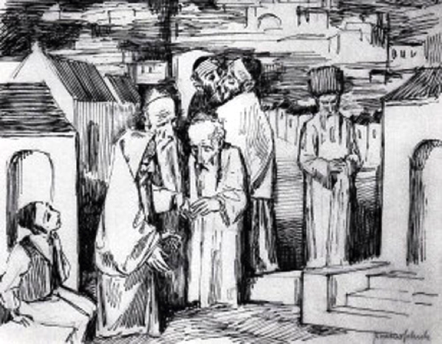
Bruno Schultz, Jews in the Cemetery
1930s
In spite of their vigorous political activity Jews have little effect on their condition in Poland. Bruno Schulz, a
native of Drohobycz, teaches art on the local gymnasium and flourishes as a Polish writer. He translates Kafka into
Polish and publishes two works of gifted visionary fantasy set in Drohobycz.
Bruno Schulz publishes his collection of stories The Cinnamon Shops and other short stories, which are
enthusiasticallyreceived by the Polish literary community.
1934
Bruno Schulz's collection of short stories, Sanatorium Under the Sign of the Hourglass, is published..
1937
1938
Bruno Schulz is honored with the Gold Laurel of the Polish Academy of Literature.
The census shows 17,0000 Jews in Drohobycz: 13,000 in Borysław and 15,000 in surrounding villages.
After 1938
Please see the Second World War

Ephraim Moses Lillien
At the Anvil, from Songs of the Ghetto

